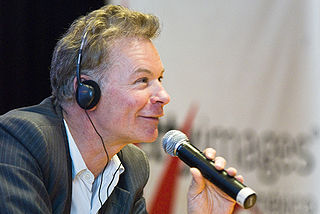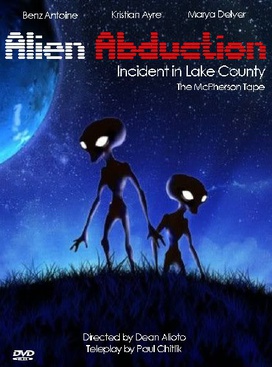
George Orson Welles was an American director, actor, writer, and producer who is remembered for his innovative work in film, radio, and theatre. He is considered to be among the greatest and most influential filmmakers of all time.
A mockumentary is a type of film or television show depicting fictional events, but presented as a documentary. The term originated in the 1960s but was popularized in the mid-1990s when This Is Spinal Tap director Rob Reiner used it in interviews to describe that film.

"The War of the Worlds" was a Halloween episode of the radio series The Mercury Theatre on the Air directed and narrated by Orson Welles as an adaptation of H. G. Wells's novel The War of the Worlds (1898) that was performed and broadcast live at 8 pm ET on October 30, 1938, over the CBS Radio Network. The episode is infamous for inciting a panic by convincing some members of the listening audience that a Martian invasion was taking place, though the scale of panic is disputed, as the program had relatively few listeners.

Alternative 3 is a 1977 British television mockumentary concerning government conspiracies. It inspired much speculation and interest by proponents of fringe ideas. It has been compared to Orson Welles' 1938 radio production of The War of the Worlds, as both were science fiction programmes, not intended to alarm the public, that were misinterpreted as legitimate.

Julien Temple is a British film, documentary and music video director. He began his career with short films featuring the Sex Pistols, and has continued with various off-beat projects, including The Great Rock 'n' Roll Swindle, Absolute Beginners and a documentary film about Glastonbury.

The Mercury Theatre was an independent repertory theatre company founded in New York City in 1937 by Orson Welles and producer John Houseman. The company produced theatrical presentations, radio programs and motion pictures. The Mercury also released promptbooks and phonographic recordings of four Shakespeare works for use in schools.

Around the World with Orson Welles is a series of six short travelogues originally written and directed by Orson Welles for Associated-Rediffusion in 1955, for Britain's then-new ITV channel. Despite its title emphasizing the world, it was entirely filmed in Europe. Among other incidents in the episodes, Welles visited Jean Cocteau and Juliette Gréco in Paris, attended a bullfight in Madrid and visited the Basque Country.

F for Fake is a 1973 docudrama film co-written, directed by, and starring Orson Welles who worked on the film alongside François Reichenbach, Oja Kodar, and Gary Graver. Initially released in 1974, it focuses on Elmyr de Hory's recounting of his career as a professional art forger; de Hory's story serves as the backdrop for a meandering investigation of the natures of authorship and authenticity, as well as the basis of the value of art. Far from serving as a traditional documentary on de Hory, the film also incorporates Welles's companion Oja Kodar, hoax biographer Clifford Irving and Orson Welles as himself. F for Fake is sometimes considered an example of a film essay.

The Stranger is a 1946 American thriller film noir directed and co-written by Orson Welles, starring himself along with Edward G. Robinson and Loretta Young. Welles's third completed feature film as director and his first film noir, it centers on a war crimes investigator tracking a high-ranking Nazi fugitive to a Connecticut town. It is the first Hollywood film to present documentary footage of the Holocaust.
Timothy Hines is an American film director, writer and producer. Best known for his adaptation of the H. G. Wells novel The War of the Worlds, he has a background in directing television commercials and short films. In 1999, he founded the independent film production company Pendragon Pictures with his colleague Susan Goforth. To date, they have produced three films together H.G. Wells' The War of the Worlds (2005), War of the Worlds – The True Story (2011) and 10 Days in a Madhouse (2015)
Oja Kodar is a Croatian actress, screenwriter and director known as Orson Welles's romantic partner during the later years of his life.
A pseudo-documentary or fake documentary is a film or video production that takes the form or style of a documentary film but does not portray real events. Rather, scripted and fictional elements are used to tell the story. The pseudo-documentary, unlike the related mockumentary, is not always intended as satire or humor. It may use documentary camera techniques but with fabricated sets, actors, or situations, and it may use digital effects to alter the filmed scene or even create a wholly synthetic scene.

It's All True is an unfinished Orson Welles feature film comprising three stories about Latin America. "My Friend Bonito" was supervised by Welles and directed by Norman Foster in Mexico in 1941. "Carnaval" and "Jangadeiros" were directed by Welles in Brazil in 1942. It was to have been Welles's third film for RKO Radio Pictures, after Citizen Kane (1941) and The Magnificent Ambersons (1942). The project was a co-production of RKO and the Office of the Coordinator of Inter-American Affairs that was later terminated by RKO.

Alien Abduction: Incident in Lake County originally titled The McPherson Tape is a 1998 American pseudo-documentary horror television film directed by Dean Alioto. Originally aired on UPN on January 18, 1998. Kristian Ayre plays Tommy, a teenager in Lake County, Montana, who is making a home movie of his family's Thanksgiving dinner when they are attacked and ultimately abducted by extraterrestrials. The film is a remake of the 1989 version by the same director.
Susan Goforth is an American actress and producer.

H. G. Wells' The War of the Worlds is a 2005 direct-to-video independent science fiction action horror-thriller film version adaptation of H. G. Wells's 1898 novel of the same name about a Martian invasion of southern England. This version was produced by the independent film company Pendragon Pictures. Unlike the adaptations set in the current day United States, this was the first film set in the novel's original 1898 Victorian England. In 2012, a re-formatted, re-worked version of the film was released as War of the Worlds – The True Story.

Battle in Seattle is a 2007 political action-thriller film written and directed by Stuart Townsend, in his directorial debut. The story is loosely based on the protest activity at the WTO Ministerial Conference of 1999. The film had its world premiere at the Toronto International Film Festival on September 8, 2007. It later screened at the Seattle International Film Festival in May 2008 and received a limited theatrical release on September 19, 2008.
Found footage is a cinematic technique in which all or a substantial part of the work is presented as if it were film or video recordings recorded by characters in the story, and later "found" and presented to the audience. The events on screen are typically seen through the camera of one or more of the characters involved, often accompanied by their real-time, off-camera commentary. For added realism, the cinematography may be done by the actors themselves as they perform, and shaky camera work and naturalistic acting are routinely employed. The footage may be presented as if it were "raw" and complete or as if it had been edited into a narrative by those who "found" it.

It's All True: Based on an Unfinished Film by Orson Welles is a 1993 documentary film about Orson Welles's ill-fated Pan-American anthology film It's All True, shot in 1941–42 but never completed. Written and directed by Richard Wilson, Bill Krohn and Myron Meisel, the film is narrated by Miguel Ferrer. It was named the year's Best Non-Fiction Film by the Los Angeles Film Critics Association, and its filmmakers received a special citation from the National Society of Film Critics.













